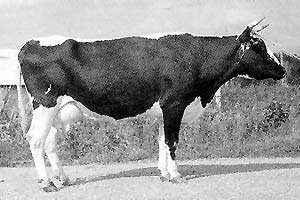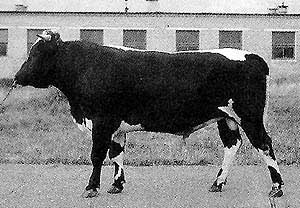Istoben Cattle
 The breed was established in the former Vyatka province (now Kirov region) by crossing
the local Great Russian cattle with the Kholmogory, Swiss Brown, Dutch and East Friesian
breeds. The development of dairy husbandry in this region was aided by a good feed
base (from flood lands in the alluvial plains of the Vyatka and Moloma rivers), the
near-by markets for selling dairy products and organized butter-making. The breed
was named after the settlement of Istoben where a large creamery was set up; the best
herds were concentrated in its vicinity.
The breed was established in the former Vyatka province (now Kirov region) by crossing
the local Great Russian cattle with the Kholmogory, Swiss Brown, Dutch and East Friesian
breeds. The development of dairy husbandry in this region was aided by a good feed
base (from flood lands in the alluvial plains of the Vyatka and Moloma rivers), the
near-by markets for selling dairy products and organized butter-making. The breed
was named after the settlement of Istoben where a large creamery was set up; the best
herds were concentrated in its vicinity.
The importation of the Kholmogory and Swiss Brown breeds began late in the 19th and early in the 20th century; later the Yaroslavl breed was imported. During 1936-37 there was an infusion of East Friesian blood. Nevertheless, crossing of the local cattle with the above-mentioned breeds was quite limited and had no major effect on the productivity of the local herds. During selection the major emphasis was placed on fat content. In 1935 the National Herdbook of the Istoben cattle was opened. The breed was recognized in 1943.
 The animals of this breed have clearly-defined dairy features; their constitution
is strong and conformation compact. The head is somewhat coarse with a long face.
The chest is deep and long but not wide enough; the ribs are well sprung, flat with
a large distance between them. The withers are narrow and medium in height. The back
and loin are long enough; the rump is long and fairly wide at the hips but narrow
at the pinbones. The legs are frequently wrongly set; cow hocks and knock knees as
well as bowed hind legs are occasionally observed. The musculature is poorly developed.
Common defects are as follows: narrow chest, sway back, sloping and narrow rump, wrongly
set legs. Coat color is mostly black or black-and-white (up to 70%), sometimes (about
25%) red or red-and-white. The udder of most cows is cup-shaped and medium in size.
The animals of this breed have clearly-defined dairy features; their constitution
is strong and conformation compact. The head is somewhat coarse with a long face.
The chest is deep and long but not wide enough; the ribs are well sprung, flat with
a large distance between them. The withers are narrow and medium in height. The back
and loin are long enough; the rump is long and fairly wide at the hips but narrow
at the pinbones. The legs are frequently wrongly set; cow hocks and knock knees as
well as bowed hind legs are occasionally observed. The musculature is poorly developed.
Common defects are as follows: narrow chest, sway back, sloping and narrow rump, wrongly
set legs. Coat color is mostly black or black-and-white (up to 70%), sometimes (about
25%) red or red-and-white. The udder of most cows is cup-shaped and medium in size.
Istoben cows on the best farm (Kirovsk Lugobolotnaya experiment station 1976) have the following measurements (in cm): withers height 129, chest depth 70, chest width 49, width at hips 51, oblique body length 162, heart girth 190, cannon bone girth 18.5. The live weight of newborn calves is 26-30 kg; that of cows is 430-480 kg and of bulls 720-790 kg.
According to the results of the 1981 evaluation the average annual milk production of pedigree animals (mature cows) was 3107 kg, and the fat content was 3.83%. The best breeding herd of the Kirovsk Lugobolotnaya experiment station produced earlier (in 1976) 4238 kg of milk with 3.96% fat. The best cows in this herd produced during their best 305-day lactation 5990-6286 kg of milk with 4.05-4.15% fat. The 1200 cows at the 50-letiye SSSR breeding state farm in Orichevsk district of Kirov region averaged, in 1983, 4023 kg of milk and 156 kg of butterfat.
Some Istoben cows have reached a record milk yield. The cow Beluga K10-64 during her 6th lactation produced 8127 kg of milk with 4.07% fat; over 12 lactations she produced 53278 kg of milk with 3.90% fat. Fara K10-1315 produced 8366 kg of milk with 4.98% fat.
Istoben cattle have satisfactory beef qualities. The structure of the breed comprises 6 major lines. The valuable features of this breed are its good adaptation to the local ecological conditions and resistance to infectious diseases. Cases of leucosis among Istoben animals are 20 times less than among the Black Pied breed.
The number of Istoben cattle on 1 January 1980 was 10,6000 head. Numbers have decreased because these cattle are not competitive compared with the leading dairy breeds. In accordance with the long-term plan of Istoben cattle breeding in Kirov region a conservation herd was established in Istobenski breeding state farm in Orichev district. The main purpose of this farm is to produce valuable bulls of the tested lines. The major technique is outbreeding; moderate inbreeding may be used within lines followed by line crossing.
To proceed with the breeding of the approved lines of this breed, a bank of deep-frozen semen of the 24 best sires representing the leading lines is being set up. With complete diet feeding the Istoben breed can be rapidly improved by crossing with the related Dutch breed.
References
Dmitriez, N.G. and Ernst, L.K. (1989) Animal Genetic Resources of the USSR. Animal Production and Health Paper Publ. by FAO, Rome, 517 pp.
